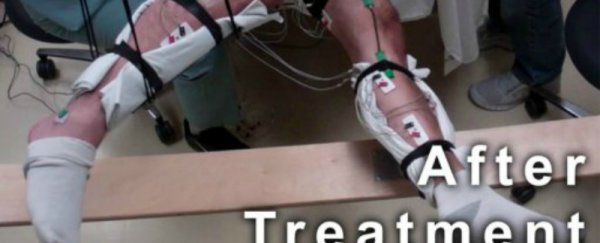Five men who were completely paralysed have taken voluntary step-like movements after undergoing a new type of non-invasive spinal cord stimulation. The new procedure simply involves placing electrodes onto their lower back, where they deliver gentle electrical stimulation to the patients' spines through their skin.
The patients still aren't able to walk and can only move their legs in small amounts while supported mid-air, but considering the fact that none of them could move their legs at all prior to the procedure, it's a pretty huge deal. The same research team had previously helped four other patients achieve small leg movements using spinal cord stimulation, but until now, they'd had to surgically implant an electrical device. This is the first time movement has been voluntarily restored without surgery.
"These encouraging results provide continued evidence that spinal cord injury may no longer mean a life-long sentence of paralysis and support the need for more research," Roderic Pettigrew, a bioengineer at the US National Institutes of Health who wasn't directly involved in the study, said in a press release. "The potential to offer a life-changing therapy to patients without requiring surgery would be a major advance; it could greatly expand the number of individuals who might benefit from spinal stimulation."
The study was carried out over an 18-week period at the University of California, Los Angeles (UCLA). Each of the five participants had been paralysed for at least two years before they were fitted with the stick-on electrodes, and they underwent one 45-minute training session each week, during which the researchers asked them to remain passive or try to move their legs while electrical stimulation was applied to their backs.
During the final four weeks of training, the men were also given a drug called buspirone, which mimics the action of serotonin and has been shown to help mice with spinal cord injuries move again.
At the start of the study, the men's legs only moved when the electrical stimulation on their backs was strong enough to generate an involuntary step. But as treatment progressed, their range of movement began to significantly improve when they 'tried' to move their legs. After just one month, the men had doubled their range of movement during electrical stimulation.
Incredibly, by the end of the study all five men were able to move their legs with no electrical stimulation at all, and the range of movement was almost the same as when they'd received stimulation. As you can see in the footage below, the results are pretty incredible:
The researchers believe that the treatment works by helping to re-establish communication between the brain and spinal cord. "It's as if we've reawakened some networks so that once the individuals learned how to use those networks, they become less dependent and even independent of the stimulation," said lead researcher V. Reggie Edgerton, a distinguished professor in biology and physiology at UCLA.
The team backed up this hypothesis by recording the electrical signals generated in the men's calf muscles while they attempted to flex their feet during stimulation, and showed that over the course of the 18 weeks, the signals got stronger and stronger.
Edgerton is now working with the same five men to see if further non-invasive spinal stimulation and training can get them back on their feet - something that the four earlier patients who had electrodes implanted on their spines have already achieved - and potentially even walk by themselves again. He's also looking into how the stimulation can help with autonomic functions such as the ability to sweat and control bladder, bowel, and sexual function, and wants to test whether the procedure can help people with partial paralysis.
"We have focused on individuals with complete paralysis throughout this whole process because we knew that was going to be the toughest patient population to see changes in," said Edgerton. "We've always thought, and we have every reason to believe, that those individuals with partial injuries have even more room for improvement."
"All patients are going to need something slightly different, and maybe non-invasive stimulation is going to be best in some cases and epidural [implanted] stimulation in others," he added. "What we need to do is maximise the clinical tool box that we have so that the physician and the patient can select a therapy that is best for them."
The results have been published open-access in the Journal of Neurotrauma.
